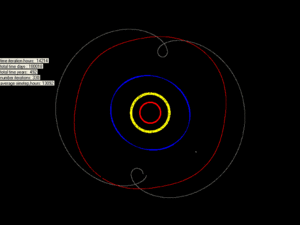astro.wikisort.org - Asteroid
(470308) 2007 JH43, provisional designation 2007 JH43, is a trans-Neptunian object in the outer regions of the Solar System, approximately 500 kilometers in diameter. It was discovered on 10 May 2007, by the U.S. Palomar Observatory in California. The team of unaccredited astronomers at Palomar consisted of Megan E. Schwamb, Michael E. Brown and David L. Rabinowitz[2]
| Discovery[1] | |
|---|---|
| Discovered by | Palomar Obs. Unaccredited: M. E. Schwamb M. E. Brown D. L. Rabinowitz |
| Discovery site | Palomar Obs. |
| Discovery date | 10 May 2007 |
| Designations | |
MPC designation | 2007 JH43 |
Minor planet category | TNO[1][2] Scat-Near (DES)[3] |
| Orbital characteristics[1] | |
| Epoch 31 July 2016 (JD 2457600.5) | |
| Uncertainty parameter 3 | |
| Observation arc | 31.34 yr (11,446 days) |
| Earliest precovery date | 7 March 1984 |
| Aphelion | 40.566 AU (6.0686 Tm) |
| Perihelion | 38.612 AU (5.7763 Tm) |
Semi-major axis | 39.589 AU (5.9224 Tm) |
| Eccentricity | 0.0247 |
Orbital period (sidereal) | 249.10 yr (90,983 days) |
Mean anomaly | 177.14° |
Mean motion | 0° 0m 14.4s / day |
| Inclination | 18.129° |
Longitude of ascending node | 64.584° |
Argument of perihelion | 4.7053° |
| Physical characteristics | |
| Dimensions | 505 km (assumed)[4] 529.08 km (calculated)[5] |
Geometric albedo | 0.09 (assumed)[4] 0.10 (assumed)[5] |
Spectral type | C[5] |
Absolute magnitude (H) | 4.49±0.05 (S)[6] 4.5[1][5] |
The minor planet orbits the Sun at a distance of 38.6–40.6 AU once every 249 years and 1 month (90,983 days). Its orbit has an eccentricity of 0.02 and an inclination of 18° with respect to the ecliptic.[1] The first precovery was taken at the Australian Siding Spring Observatory during the Digitized Sky Survey in 1984, extending the body's observation arc by 23 years prior to its discovery observation.[2] It came to perihelion around 1888.[1]
Orbital classification
The Minor Planet Center lists 2007 JH43 as a trans-Neptunian object or a distant object in the Kuiper belt.[2][7] The Deep Ecliptic Survey currently shows it as a scattered object, based on a 10-million-year integration of the orbit.[3]

References
- "JPL Small-Body Database Browser: 470308 (2007 JH43)" (2015-07-09 last obs.). Jet Propulsion Laboratory. Retrieved 16 November 2016.
- "470308 (2007 JH43)". Minor Planet Center. Retrieved 16 November 2016.
- Marc W. Buie. "Orbit Fit and Astrometric record for 470308". SwRI (Space Science Department). Retrieved 27 May 2020.
- Wm. Robert Johnston (24 March 2015). "List of Known Trans-Neptunian Objects". Johnston's Archive. Retrieved 2015-07-22.
- "LCDB Data for (470308)". Asteroid Lightcurve Database (LCDB). Retrieved 16 November 2016.
- Benecchi, Susan D.; Sheppard, Scott S. (May 2013). "Light Curves of 32 Large Transneptunian Objects". The Astronomical Journal. 145 (5): 19. arXiv:1301.5791. Bibcode:2013AJ....145..124B. doi:10.1088/0004-6256/145/5/124. S2CID 54183985. Retrieved 16 November 2016.
- "MPEC 2010-S44 : DISTANT MINOR PLANETS (2010 OCT. 11.0 TT)". IAU Minor Planet Center. 2010-09-25. Retrieved 2014-04-06.
External links
На других языках
[de] (470308) 2007 JH43
(470308) 2007 JH43 ist ein großes transneptunisches Objekt im Kuipergürtel, das bahndynamisch als Plutino oder als Scattered disc object eingestuft wird. Aufgrund seiner Größe ist der Asteroid ein Zwergplanetenkandidat.- [en] (470308) 2007 JH43
Другой контент может иметь иную лицензию. Перед использованием материалов сайта WikiSort.org внимательно изучите правила лицензирования конкретных элементов наполнения сайта.
WikiSort.org - проект по пересортировке и дополнению контента Википедии

